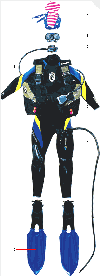Tech Goes Deep
Seven ways to dive farther, swim faster, and avoid confrontations with nature.

Photograph by John B. Carnett
Despite the inherent danger, scuba became all the rage not long after Jacques Cousteau invented the Self-Contained Underwater Breathing Apparatus in 1943. (In fact, in July 1953, Popular Science showed readers how to make their own gear.) Almost 60 years later, scuba is still growing in popularity, with 3 million certified divers in the United States alone. The major reason: New technology continues to make it safer and cheaper. This year’s top advances allow you to …
1. Wear a more comfortable suit
Finally, a scuba suit that doesn’t feel like a straight jacket. O’Neill’s new 3000 X ($216) borrows high-tech fabrics from surfing wet suits. Chief among them: Thin
Ultraflex neoprene in the arms and shoulders provides less resistance and a
greater range of motion. Extra protection on the chest prevents body heat from
escaping.
2. Customize your fins
Different conditions require different fins. If you’re exploring, you’ll want long fins for speed. If you’re observing reefs, you’ll want short fins for control. Force Fin’s new Launch Pad ($250 to $350) has eight interchangeable blades, including the long and flexible Oscillating Propulsion System blade (shown) that’s designed for lengthy underwater swims.
www.forcefin.com
3. Be seen if you get in trouble
The spandex Scuba Do Rag ($35) keeps your hair from tangling in the web of hoses and dries in
minutes. More important, it makes you more visible to other divers. Available in a full-headed
version too.
www.cococheznaynay.com
4. See more fish
Direct eye contact scares fish away. Designed in France for spearfishermen, the Samurai Elite ($60) goggles use mirror-tinted lenses
to hide your peepers so the fish stay put.
5. Breathe easier as you dive deeper
The “M” on the Atomic M-1 Regulator ($699) stands for Monel, an exotic metal that works well for both air and
the rich oxygen mixtures many divers use. But it’s the regulator’s flow-control system that’s most revolutionary. As you dive deeper and the pressure builds, the regulator automatically speeds airflow to ensure you’re getting enough oxygen.
6. Become more buoyant (quickly)
Maintaining proper trim is everything to a diver, and the Dacor Nautica Airtrim Buoyancy Compensation Device ($575) is far more intuitive than most. Two buttons near the waist let you fill or deflate the vest without fumbling around your shoulder for valves. Twin pneumatic exhaust valves on the shoulder and lower part of the jacket allow you to dump air at any angle.
7. Repel dangerous predators
The SeaChange Shark Shield ($500) emits an electrical field that wards off predatory sharks but doesn’t affect humans or other fish. As a less bulky, more powerful version of the commercial Shark Pod, it’s the first personal shark repellent. The field constantly switches between positive and negative so the receptors in the shark’s snout can’t adapt. Weighing in at just a pound, the cassette-size device is powered by a small rechargeable battery and provides a 13- to 16-foot protective bubble for 4 hours. There’s a leash for surfers as well.